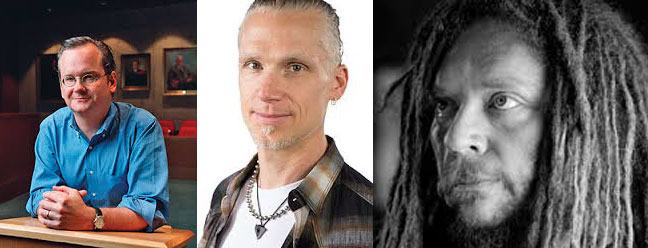In developing the Sleep and Dream Database (SDDb), a digital archive and search engine for dream research, I have been acutely aware that I possess no formal training in computer science or internet technology. My doctoral degree is in religion and psychological studies, and I learned many things in the course of my graduate education, but nothing about how to conceive, build, or use a digital database.
Fortunately I’ve benefitted from the wisdom of three people—Larry Lessig, Kurt Bollacker, and Jaron Lanier—who have helped me understand how to translate my psychology of religion interest in dreams into the functional mechanics of a digital database.
 Larry Lessig was a first-year law school student with my soon-to-be wife at the University of Chicago, at the same time I was a doctoral student at the U. of Chicago Divinity School. It was 1986 and 1987, and we spent a lot of time hanging out with Larry and a few other frighteningly smart, frighteningly conservative law students. Once I asked Larry what he was doing for fun, and he said he was spending a lot of time in cyberspace. I had recently read William Gibson’s 1984 novel Neuromancer, which popularized the term cyberspace, and excitedly I said to Larry, I’ve been reading Gibson’s work too, it’s so interesting how he envisions a disembodied reality of pure information flows…. Larry let me finish, then said he was spending time in actual cyberspace, exploring the earliest iterations of the world wide web. While I was reading cool science fiction about cyberspace, Larry was really in cyberspace, figuring it out, studying its original development as it happened.
Larry Lessig was a first-year law school student with my soon-to-be wife at the University of Chicago, at the same time I was a doctoral student at the U. of Chicago Divinity School. It was 1986 and 1987, and we spent a lot of time hanging out with Larry and a few other frighteningly smart, frighteningly conservative law students. Once I asked Larry what he was doing for fun, and he said he was spending a lot of time in cyberspace. I had recently read William Gibson’s 1984 novel Neuromancer, which popularized the term cyberspace, and excitedly I said to Larry, I’ve been reading Gibson’s work too, it’s so interesting how he envisions a disembodied reality of pure information flows…. Larry let me finish, then said he was spending time in actual cyberspace, exploring the earliest iterations of the world wide web. While I was reading cool science fiction about cyberspace, Larry was really in cyberspace, figuring it out, studying its original development as it happened.
I look back on that conversation and think of it as planting a seed that’s coming to fruition now with the SDDb. In 1999 Larry wrote a book called Code, and Other Laws of Cyberspace, and from that book I’ve learned the basic principle that everything we create in the digital world depends on the choices we make about how to structure information and its access. It’s not just machines doing things on their own, it’s us making machines that do certain things and not others. We can make good choices or bad choices about how we design those machines, freedom-affirming choices or freedom-limiting choices.
Thanks, Larry, for helping me understand that.
 I met Kurt Bollacker through Dominic Luscinci, a statistician in San Francisco who had worked with Kurt on another database design project. I really can’t believe my good fortune in having Kurt help me turn the SDDb from several pages of scribbled notes into a highly functional reality. I’ve learned a little about his work as Digital Research Director of the Long Now Foundation, and it reassures me that I have found a person who has not only the technical skill to build the SDDb but also the philosophical vision to see where the digital future is leading us, and to design the database with that vision in mind.
I met Kurt Bollacker through Dominic Luscinci, a statistician in San Francisco who had worked with Kurt on another database design project. I really can’t believe my good fortune in having Kurt help me turn the SDDb from several pages of scribbled notes into a highly functional reality. I’ve learned a little about his work as Digital Research Director of the Long Now Foundation, and it reassures me that I have found a person who has not only the technical skill to build the SDDb but also the philosophical vision to see where the digital future is leading us, and to design the database with that vision in mind.
One of the things I learned from Kurt early on was, “Data accumulate value over time.” I’ve adopted that as a kind of mantra for the SDDb. Data accumulate value over time. Information that seems trivial or useless today can be a treasure to researchers in the future. An awareness of that historical dynamic has a practical consequence for building databases: It means we should aim at a simple, flat, and state-free architecture that can exist independently of any specific type of software. Because software systems come and go, the best way to create a database that will endure far into the future is to structure the information in a way that will make it easy to transfer from one type of software to another. That’s a key principle in the overall design of the SDDb, and one that I hope will make the database useful to dreamers and researchers for many years to come.
For that and more, thanks, Kurt.
 The third person I want to acknowledge as an influence is Jaron Lanier and his book You Are Not a Gadget. I’m a religious studies scholar, so forgive me, but Jaron strikes me as a latter-day techno-prophet, warning us of the apocalyptic perils that lie ahead if we allow soulless machines to become our masters. His book is a passionate call to fight against “cybernetic totalism” and the economic power of “lord aggregators” of the web—I love that term—whose driving interest is to commercially exploit our personal information. As someone trying to build a database that includes a lot of personal information, I have thought long and hard about Jaron’s cautionary ideas, and I’ve done my best to design the SDDb in a way that will enhance rather than diminish people’s freedom and creativity in exploring the world of dreams.
The third person I want to acknowledge as an influence is Jaron Lanier and his book You Are Not a Gadget. I’m a religious studies scholar, so forgive me, but Jaron strikes me as a latter-day techno-prophet, warning us of the apocalyptic perils that lie ahead if we allow soulless machines to become our masters. His book is a passionate call to fight against “cybernetic totalism” and the economic power of “lord aggregators” of the web—I love that term—whose driving interest is to commercially exploit our personal information. As someone trying to build a database that includes a lot of personal information, I have thought long and hard about Jaron’s cautionary ideas, and I’ve done my best to design the SDDb in a way that will enhance rather than diminish people’s freedom and creativity in exploring the world of dreams.
I read Jaron’s book in the summer of 2011, and soon afterwards he was profiled in a New Yorker magazine article. The article was actually kind of lame, focusing more on his counter-cultural appearance and behavior than the substance of his ideas. Well, as fate or synchronicity would have it, the day after the New Yorker article came out, I bumped into Jaron down at the market, Andronico’s at the corner of Shattuck and Cedar in north Berkeley. He was there with his daughter in the produce section. Normally I’m very reluctant to just walk up and talk to anyone, let alone prominent people, but this was too coincidental, especially since I had learned in Jaron’s book about a 15th century text called “Poliphili’s Strife of Love in a Dream,” a fantastic dream text I’d never heard of before, which I immediately bought and started reading.
So anyway, we were both picking through the lemons, and I went ahead and said hi, I just read that New Yorker article about you. Jaron said yeah, he didn’t really recognize the person they were describing in the article. I quickly tried to think of something to say about how much I valued his ideas, but I’m not a very quick thinker, so all I could come up with was to say thanks for teaching me about “Poliphili’s Strife of Love in a Dream.” I’m sure that comment came across as completely weird and off the wall, and so I hastily moved on to the cereal aisle, and that was that.
So Jaron, if you ever see this, I’m really sorry for stalking you in the Andronico’s produce section a couple of years ago. What I really want to do is thank you, along with Larry and Kurt, for inspiring the mission, the content, and the code of the Sleep and Dream Database. Thanks to you all.


